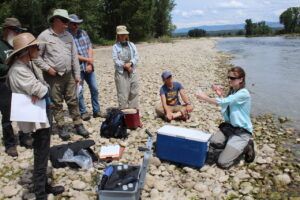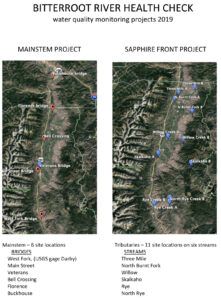
The USDA Forest Service has partnered with the Bitterroot River Protection Association (BRPA) to conduct water quality monitoring on Bitterroot National Forest system lands within the Bitterroot River Basin.
BRPA, in a partnership with the Montana Department of Environmental Quality (DEQ), Bitterroot College, University of Montana and other groups involved in the Bitterroot River Health Check program, have been conducting ‘Citizen Science’ water quality monitoring on the main stem and some tributaries of the Bitterroot River since 2017. The purpose of the monitoring is to provide information to DEQ and the general public on water quality within the Bitterroot River watershed, particularly on streams already identified as impaired. BRPA wishes to develop long-term monitoring sites on the Forest in an effort to determine a baseline for the quality of water leaving the Wilderness and Forest respectively. This data could benefit the long term monitoring plans on Bitterroot National Forest lands within the Bitterroot River Basin.
“Both parties will benefit by long term monitoring of water quality on the National Forest,” said Darby District Ranger Eric Winthers. “We appreciate the efforts of BRPA and the many partners and volunteers who are working with us on this important project.”
BRPA executive director Michael Howell said that due to a shortage of state funds and personnel involved in long term monitoring in the Clark Fork River Basin, in 2010 DEQ reduced the program monitoring on the Bitterroot River to a site at Maclay Bridge in Missoula where it discharges into the Clark Fork River. 
“By partnering with BRPA’s locally based ‘citizen science’ volunteer program in 2017,” said Howell, “DEQ was able to extend its long term monitoring to cover the entire Bitterroot River main stem again.” He said that, based on the initial success of this monitoring program, DEQ was able to adopt and initiate a plan in 2019 to monitor the river at five locations for the next 20 years. According to Howell, a locally based cooperative was formed called the Bitterroot River Health Check to sustain this monitoring and another plan was developed to monitor six tributaries on the Sapphire Front “in perpetuity.” The Bitterroot River Health Check has been conducting the sampling on the main stem since 2017 and on the tributaries since 2018.
“One very important thing to understand,” said Howell, “is that BRPA could not be doing all this on its own. These kinds of things can happen only when the whole community gets involved. Without support from individuals and businesses serving like spokes in a wheel, without a few extra strong spokes like BRPA, Bitterroot Trout Unlimited and Bitterrooters for Planning, and the Clark Fork Coalition, without an MOU with the Bitterroot College to serve as the hub, without the equipment to throw in the cart provided by the Rapp Family Foundation, and without the incredible group of ‘Citizen Science’ volunteers who are pulling the cart along, we would probably still only be monitoring the Bitterroot at Maclay Bridge.”
Howell said this new MOU between the Bitterroot National Forest and the Bitterroot River Health Check program makes the Bitterroot River Watershed home to one of the most extensive and robust long term water quality monitoring programs in the state.
“To have the biggest land manager in the county, who manages over 75% of the land base in the watershed, get on board with our monitoring progam is extremely exciting,” said Howell, “and we look forward to working with the Forest Service on specific projects along the Bitterroot Front as they develop and implement their management activities there in the coming years.”
“Bitterroot Trout Unlimited is proud to be a part of this continued effort to maintain excellent water quality that is the lifeblood of our valley,” said BRTU president Jeremy Anderson.
“We commend the BRPA for spearheading this collaborative effort,” said John DeArment, science director with the Clark Fork Coalition. “Data collected by The Bitterroot River Health Check will fill some critical gaps in our understanding of potential pollution sources throughout the Bitterroot River Watershed, and the program dovetails nicely with similar efforts aimed at protecting water quality throughout the larger Clark Fork River Basin all the way downstream to Lake Pend Oreille.”
George Furniss, hydrology professor at the Bitterroot College, University of Montana, agreed, saying, “The Bitterroot College is proud to be a community partner in all hands-on scientific research involving our watershed.”
Howell said that the strict citizen science based protocols guiding their volunteers in the field are being modified to incorporate all the safety precautions being advocated by health officials including maintaining proper distances between volunteers throughout the training and sample collection process. He said the training sessions have usually been held in late spring and the first sampling in the field does not usually begin until after high water in late June or early July.
“We have time to prepare,” said Howell. “Collecting uncontaminated water samples for lab analysis by following strict protocols is at the core of our volunteer program. Now we are adding to this another set of protocols designed to keep our volunteers uncontaminated as well.”
For more information about the Bitterroot River Health Check program, call Michael Howell at 239-4838.
